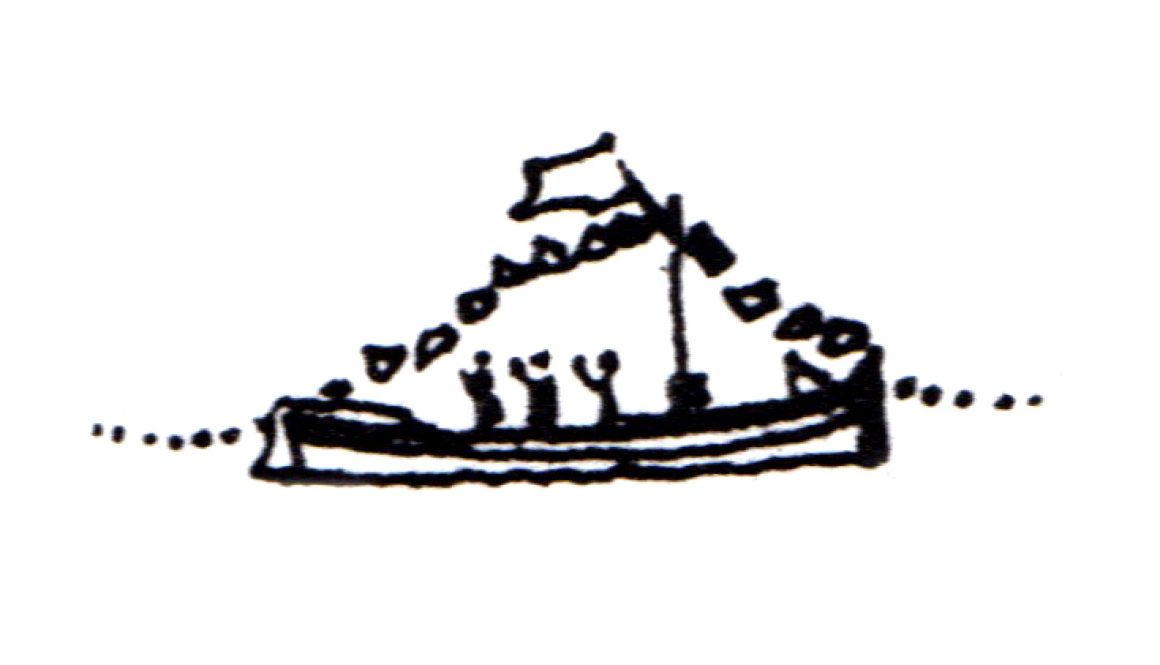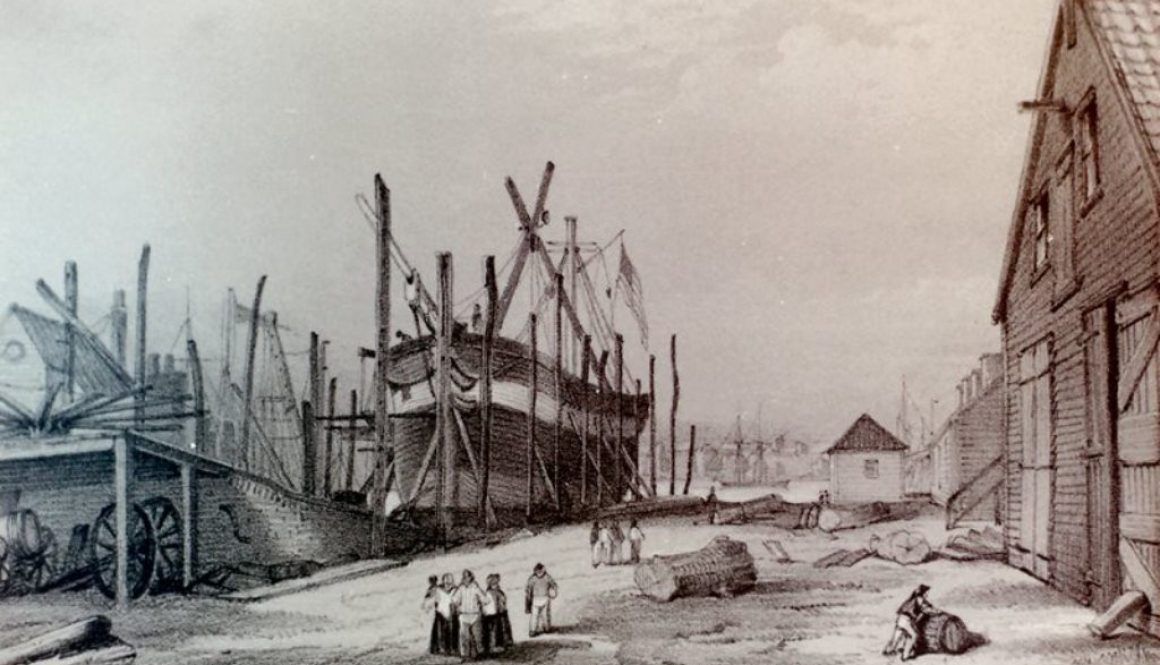Delivery to Lewes, Sussex
In 1932 Thalatta is known to have delivered materials to Lewes in Sussex to build a new railway line.
Thalatta’s years carrying cargo, from 1906 until 1967
In 1932 Thalatta is known to have delivered materials to Lewes in Sussex to build a new railway line.

On 19 May 1923 Thalatta was sold to her skipper, Captain Herbert John Howlett Body, who removed the engine, and replaced her gaff rigged mainsail with a spritsail, but she retained her gaff mizzen – making her a mulie. This reduced the crew from the boomie’s four to two men and a boy. Body traded her to ports on the north-east for coal and the south coast with wheat, as well as the near continent.
At the end of the war Percy Richmond left Thalatta and one of the Wynnfield Company’s wartime skippers, Herbert John Body, of Southend, took over as skipper. Thalatta was employed taking materials to the depths of war-torn Flanders for post-war rebuilding. Many years later, Thalatta was recalled by a Mr E. Taylor of Chatham, who was at that time a boy working in the barges, as working her way up the canal through the barren, empty, sorrowful fields of Ypres, so recently the scene of unimaginable horrors. Mr Taylor recalled the absolute quiet of that awful place – ‘a quiet that belonged to a hundred thousand dead’ – which seemed to him more horrifying than all the din of battle. Between 1919 and 1921 Thalatta’s passages took her to Paris, Antwerp, Brussels and Rotterdam. After that she carried cement to Torquay, china clay from Fowey to Greenhithe, and granite chippings from the Channel Islands.

On 25 May 1917 Thalatta was sold to Wynfield Shipping Co of Grimsby. A 70 hp two-cycle vertical oil engine was fitted in the former skipper’s cabin aft, built by Plenty & Sons of Newbury. She was used as a supply vessel to the Humber boom defences, with Percy Richmond as her skipper (who had previously been mate under James Alliston). Her fore-hold was converted to accommodate her crew which now included an engineer. Her rig was cut down and she worked from Grimsby as a motor barge – her original registration as a sailing vessel was cancelled.

Thalatta carried some coal freights to the continent (and once returned home with a cargo of eau de Cologne!) before being taken over by the Royal Navy for use as a fleet supply vessel. The Navy gave her a small semi-diesel engine as an auxiliary, but according to all accounts this was never very much use to her, and it was removed a year or two after her return to civilian employment.
In January 1909, when loaded with maize from the London Docks, she was in collision with the steamer Forth in Blackwall Reach, sustaining considerable damage to her starboard side, and had to be repaired by Shrubsall’s at Greenwich before continuing her voyage.
In November 1908 she was caught in a heavy storm when on passage from Sunderland to the Thames, and was towed into Lowestoft with a broken main gaff and a torn sail; seven other barges were either lost or driven ashore in this storm.

Barge Launched at Harwich
An interesting ceremony was witnessed in the shipbuilding yard of Mr W McLearon, at Harwich today (Tuesday 6 February 1906) when a new barge, which has been built in the yard, was launched in the presence of a large number of people. The barge, which was christened the Thalatta is owned by Mr Frederick William Horlock, the well known boat owner of Mistley. She is a fine business like looking craft, being 89 feet long, beam 20ft 6 inches, depth 7 feet 6 inches, and her tonnage is 150. She will be used for the coasting and continental trade. The barge was decorated with flags and the christening ceremony was performed by Mr Horlock’s little daughter, Coralie Clare, who broke a bottle of champagne over the bows, after which the vessel glided beautifully into the water, amid three hearty cheers, the launch being a highly successful one. The Thalatta immediately proceeded to Mistley to load a cargo of wheat for London, and will afterwards proceed to the continent.

Thalatta left Harwich for Mistley to load her first cargo, wheat for London. In 1906, as well as the east coast ports of Lowestoft, Harwich, Mistley, Hull and London, her passages took her to the near continent including Antwerp, Dunkirk, Nieuwpoort and Rotterdam. She also carried malt to Ireland. These destinations clearly indicated that she was considered to be a good sea-going vessel – a quality which not all of her kind could claim. Her first skipper was Jim Alliston, of Mistley.

Thalatta was built at the naval yard in Harwich by W. B. McLearon, who from 1905-1906 was Mayor of Harwich. The sailing barges that came from McLearon’s yard were considered to be the finest that could be found anywhere on the coast, as collectively they survived in better condition than those from any of the other builders of the time. Mclearon was also a builder of wooden lightships for Trinity House, and this is further proof of the exceptionally high quality of his work and materials.
Thalatta was built as a speculation along with her sister barge Ena. As Thalatta took shape she aroused local interest – onlookers commented on her fine head belonging more to a fishing smack than a barge. Her cargo carrying capacity was less than other barges of a similar size being built elsewhere on the coast, the Hydrogen or the Cambria, nor was she designed primarily for speed like the Ethel May, also under construction at that time by Mr Cann at the other Harwich barge yard. But her hull looked likely to be particularly capable and comfortable at sea. She was built narrow on the bottom, with long runs after to a neat sternframe. A Mistley bargeman remarked admiringly as he looked down on her decks from aloft years later, ‘she sits on the water like a little old seagull, this one’.
Thalatta was launched in a ceremony on 6 February 1906 by Coralie Clare Horlock, daughter of the new owner, Frederick W. Horlock of Mistley. She broke a bottle over the bows of the new barge which then slid gracefully into the water.